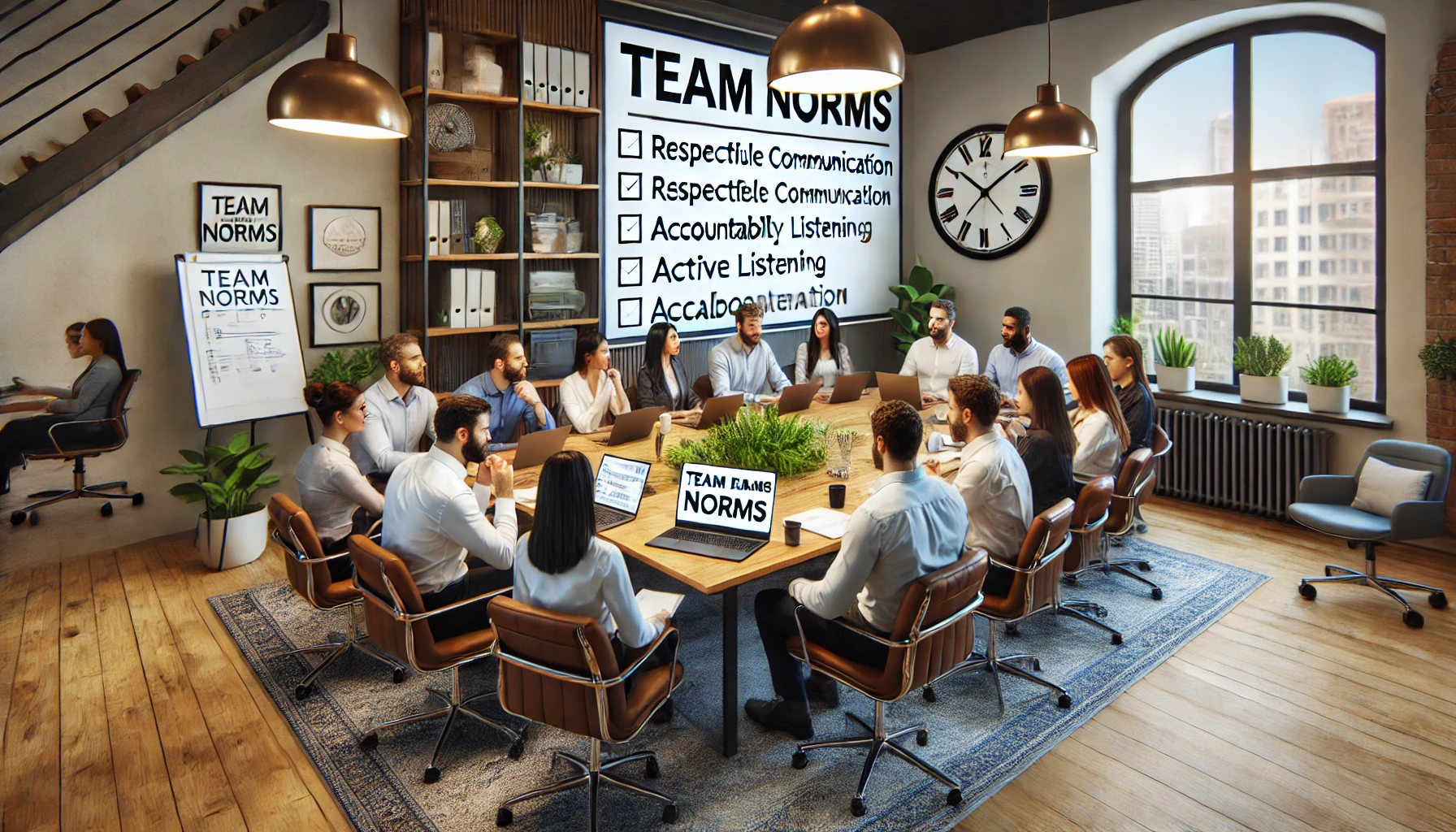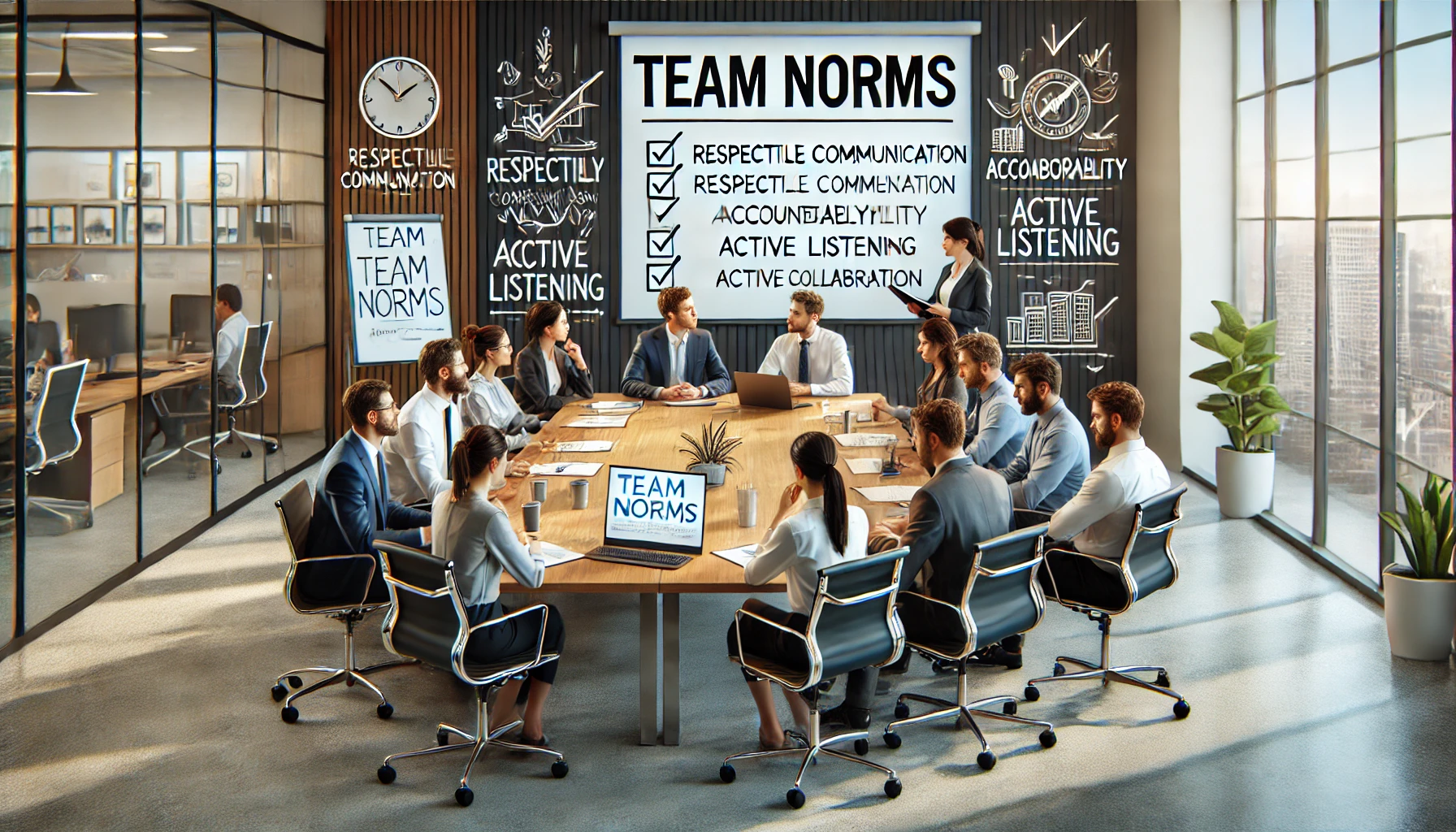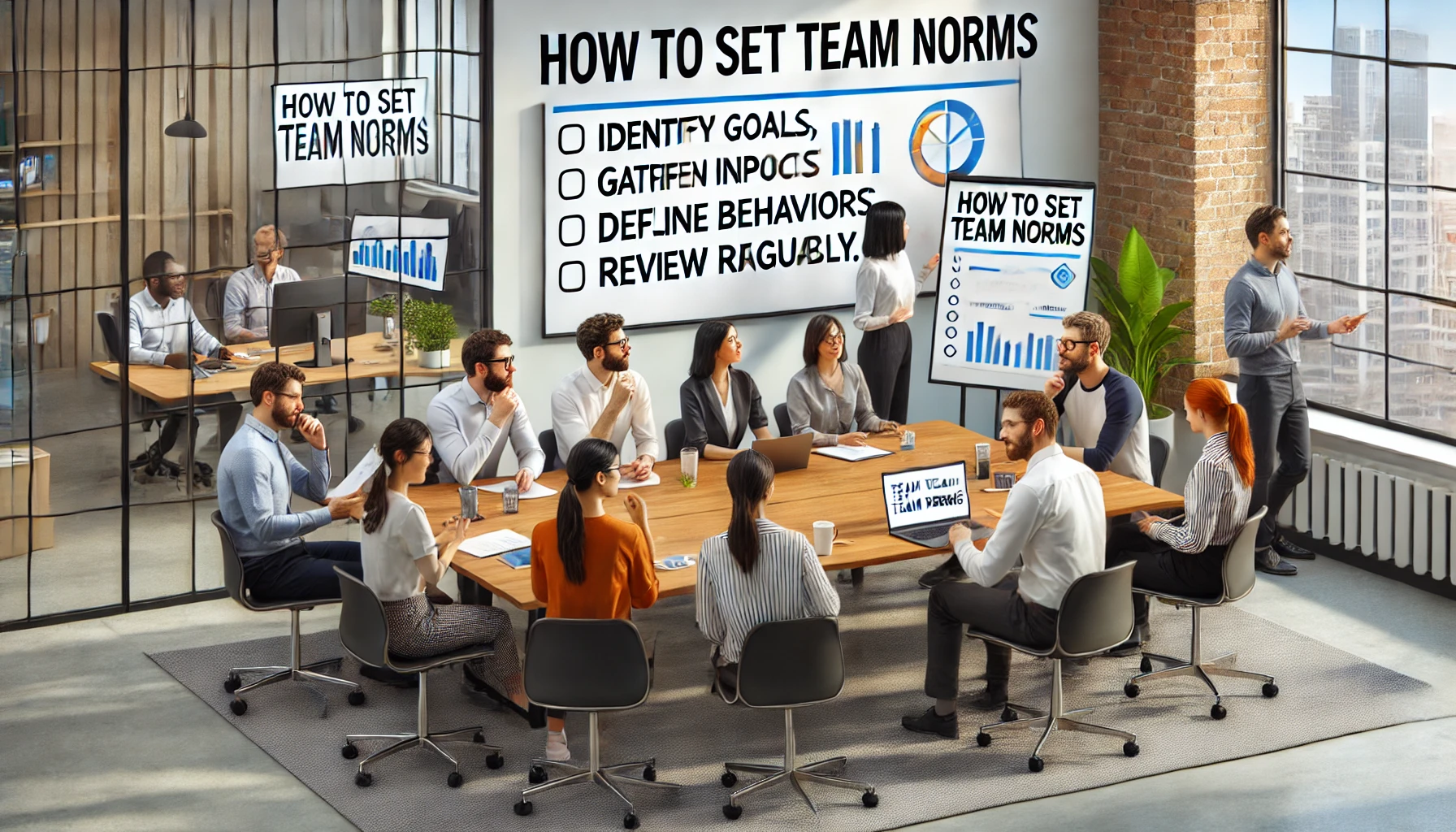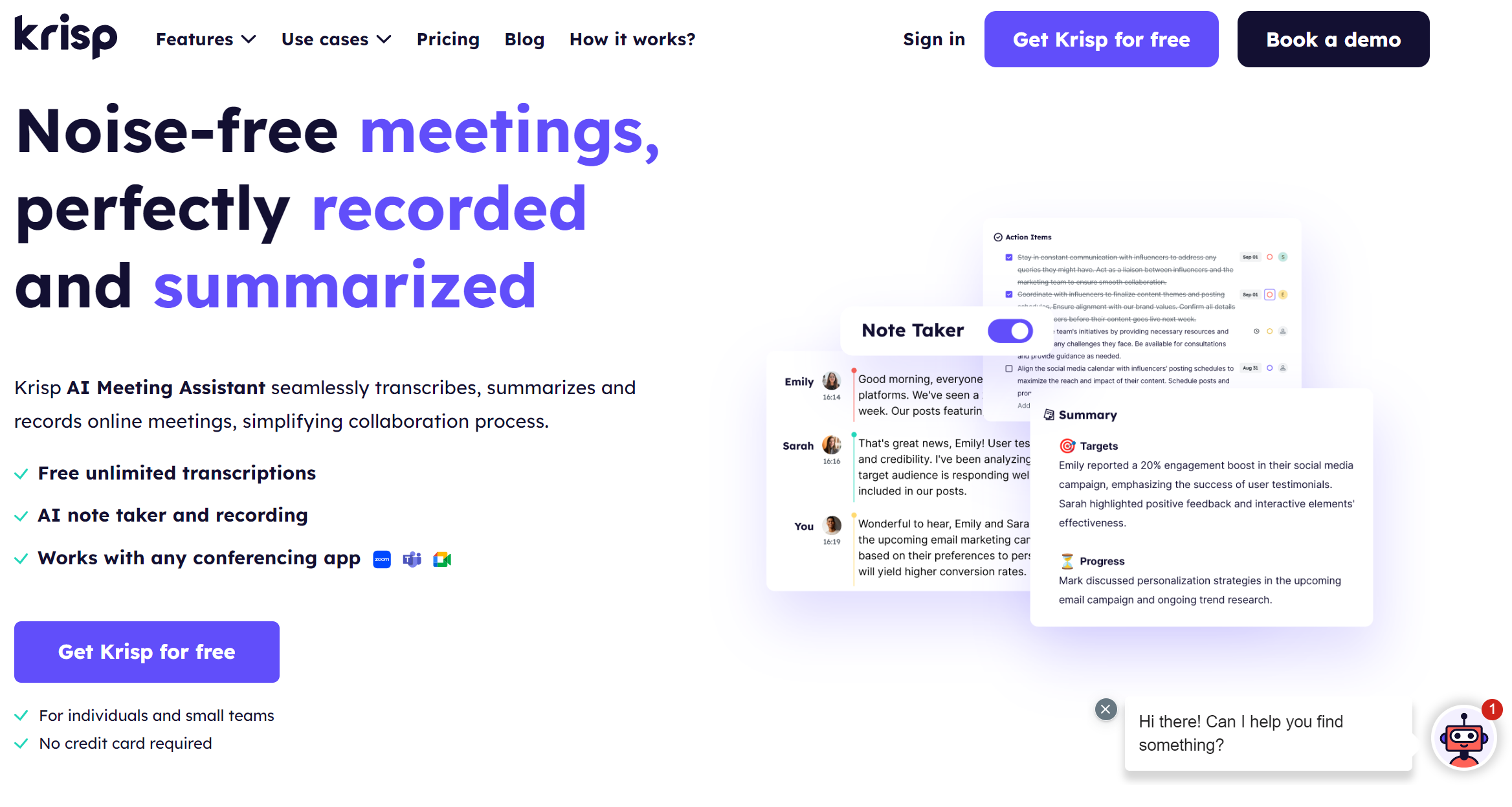Wondering why some teams just click while others struggle to get things done? The secret often lies in team norms. Usually, they’re called group norms.
Team or group norms are the shared expectations and rules guiding members’ interactions and collaboration. And good team norms, from punctuality to communication style, help create a cohesive and productive work environment.
This article gives the team norms definition, provides examples, and explains how group members should interact and collaborate successfully.
Importantly, it uncovers the connection between team norms and the Meeting Assistant Krisp, helping you to enhance your team’s productivity.
Norms. What Are Team Norms?

“Individually, we are one drop. Together, we are an ocean,” said Japanese author Ryunosuke Satoro. And norms help the drops coexist in harmony.
Norms are shared expectations and informal social rules that guide individuals’ behavior. And team or group norms are standards that ensure consistency, predictability, and cohesion within a team, regulating our social life.
These unwritten rules are influenced by our goals, values, and culture. And they’re accepted as normal behavior within a social group, like a company or an ethnic group.
For example, shaking hands in Western cultures or bowing in Japan are standards established by norms.
What’s the difference between team norms and social roles? The latter roles refer to how individuals behave in specific situations based on their positions. Social roles are associated with rights, responsibilities, expectations, and social norms.
For example, social roles refer to family roles, such as a parent and a sibling, or occupations, such as a teacher and a doctor, or societal functions, such as a leader and a citizen).
What Are Five Team Norms?

“We found that groups of size three, four, and five outperformed the best individuals. We attribute this performance to the ability of people to work together to generate and adopt correct responses, reject erroneous responses, and effectively process information,” said researcher Dr. Patrick Laughlin.
And team norms are critical in creating harmony in groups so they can perform effectively and productively.
Five Agile Norms for Teams
Wondering “What is an example of a group norm?” Here are critical team norms to consider:
-
Respectful Communication
Respectful and effective communication in the workplace helps team members feel valued and heard. This norm involves active listening with no interruptions and polite speaking, even during disagreements.
Moreover, effective workplace communication means exchanging ideas and thoughts concerning work. Such communication boosts employee motivation, engagement, and satisfaction, thus reducing conflicts and increasing productivity.
Did you know ineffective communication causes U.S. businesses to lose $1.2 trillion yearly, as Grammarly’s State of Business Communication Report 2023 shows?
For example, consider phrases like “I understand your point, but I see it differently…” Such a respectful tone can ensure productive and effective communication. Additionally, provide regular feedback by highlighting positive examples and addressing areas for improvement.
-
Accountability
Accountability is about taking responsibility for one’s tasks and outcomes. Specifically, accountability encourages team members to meet deadlines, deliver quality work, and own up to mistakes.
Establishing this norm in the workplace involves setting deadlines, delegating tasks, specifying ownership, and acknowledging success.
For instance, a team member might say, “I missed the deadline, but here’s my plan to get back on track.” To increase accountability, clearly define roles and responsibilities and establish regular check-ins.
Moreover, ensure team members readily admit their mistakes, considering this an opportunity for growth rather than a cause for blame.
-
Collaboration
Collaboration ensures team members work together towards common goals, leveraging each team member’s strengths, such as problem-solving and accountability.
Specifically, this norm means encouraging team members to share information, support each other, and actively participate in group activities, such as discussions and idea generation.
Did you know collaboration can be synchronous, where team members interact in real-time, such as during online meetings, and asynchronous, such as time-shifted interaction, when team members upload documents?
For example, encourage everyone to contribute ideas during brainstorming sessions to foster a collaborative environment. In addition, consider using collaborative tools like the Krisp Meeting Assistant and platforms like Slack and Trello to improve teamwork.
-
Constructive Feedback
Healthy and constructive feedback provides specific, actionable suggestions to help team members reveal their strengths and weaknesses and work on improving them. Did you know 86% of people want feedback, but only 48% are eager to deliver it?
Thanks to constructive criticism, you can clarify team members’ expectations, encourage fresh perspectives, and boost team morale.
For instance, you could say, “Your presentation was clear, but adding more data could strengthen your argument.” Or instead of saying, “I wish your app worked better,” try an alternative like “What if your app included these features?”
Importantly, integrate your feedback into the workflow to make it regular. It’s also essential to create a safe environment that encourages team members to share and receive feedback comfortably.
-
Adaptability
Adaptability in the workplace is a vital mental resource, making us open to change and willing to adjust plans as necessary. Specifically, adaptability refers to our cognitive, behavioral, and emotional adjustment in situations of change, novelty, and uncertainty.
Establishing this norm in the workplace helps team members more flexibly respond to new information, challenges, or opportunities. Thus, adaptability is an advantage in navigating challenges during uncertain times.
Did you know adaptability comprises three key components: acting, thinking, and feeling? Moreover, workplace adaptability is the “top skill,” according to LinkedIn’s “The 2024 Most In-Demand Skills” report.
For example, team members should be ready to pivot their strategies anytime a project’s scope changes. So, regularly discuss potential changes and their implications so team members can feel more comfortable adapting as needed. Moreover, acknowledge innovative thinking and flexibility.
So, let’s get down to business:
- Be punctual
- Maintain a respectful tone while communicating
- Listen actively
- Avoid interrupting others
- Present your expectations
- Manage time effectively
- Assign meeting roles and responsibilities
- Follow-up on action items.
Why Are Team Norms Important? Benefits of Group Norms
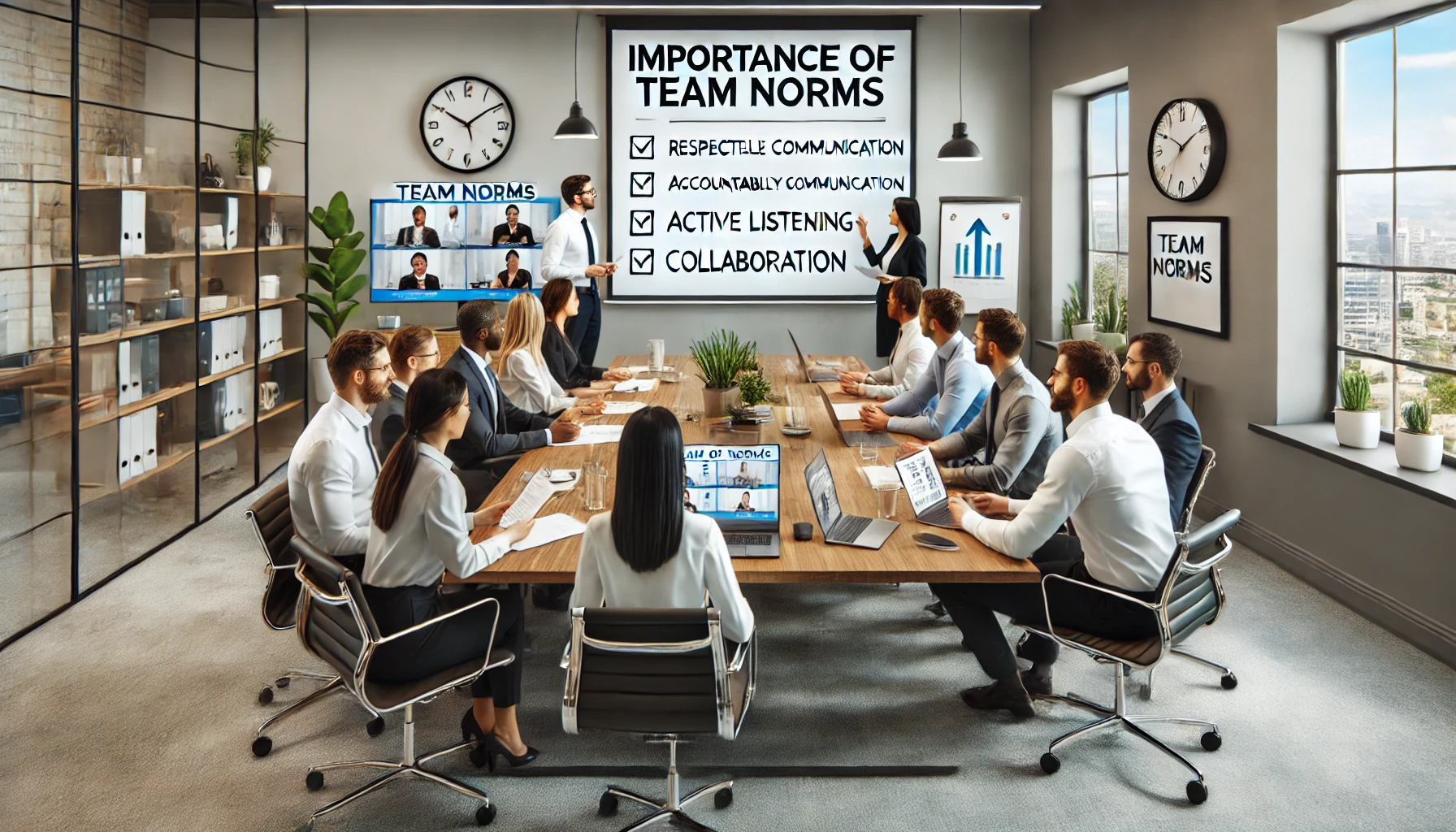
Team or group norms define normal behavior within a group. Specifically, these unwritten rules offer multiple advantages, such as:
- Foster trust and respect
- Encourage team cohesion and accountability
- Eliminate conflicts and clashes
- Avoid miscommunication and misunderstanding
- Encourage self-discipline
- Strengthen effective and productive workplace culture based on different work styles
- Make members more adaptable to new situations
- Explain new team members their roles and expectations quickly
- Shape interactions and enhance collaboration organically, not formally.
Thus, establishing effective team norms is vital because they ensure smooth operations and cohesive teamwork for new and existing teams. And this is key to achieving team success.
For instance, norms, such as respectful communication and collaboration, help teams go through the four stages of development quickly and hassle-free.
The four stages include the Forming, Storming, Norming, and Performing stages. During these stages, members face challenges like distrust, miscommunication, conflicts, and clashes to reach satisfaction in team results.
Now, let me show you how you can define norms for your team.
How to Set Team Norms: Tips & Tricks for Success

Knowing how to define your team norms is based on how members interact, communicate, share, collaborate, and coordinate. Let’s dig a little deeper to see how you should define norms for your team.
1. Consider Your Team Members’ Unique Needs
Start by determining your team’s purpose and goals. In addition, consider whether your team works in a client-facing environment, collaborates with other departments, deals with high-pressure situations, or participates in virtual meetings.
For example, if your team frequently collaborates with other departments, establish a norm for regular cross-departmental check-ins to ensure seamless communication and collaboration.
2. Ask Team Members to Share Their Experience
Ask each member to recall their worst team experience and write down what made it terrible. Then, have them reflect on their best team experience and note what made it positive. Allocate two minutes for each reflection.
For instance, ask, “Think of the worst team you’ve been part of. What factors contributed to its dysfunction?” In addition, ask, “Recall the best team you’ve ever been part of. What elements fostered success and collaboration?”
3. Use Team Members’ Suggestions
Ask team members to suggest behaviors contributing to the team’s success. Specifically, pay attention to the most relevant issues or actions that could address the team’s biggest challenges. Moreover, keep track of suggestions on a screen or large sheet of paper visible to all team members.
For example, ask questions such as, “What specific behaviors do you think would help us tackle our current challenges?” or “Can you suggest any team norms that would enhance our collaboration and productivity?”
4. Make Norms Specific
Specific norms ensure they’re actionable. Encourage the team members to provide input during business meetings. Gather their feedback through meetings, one-on-one sessions, or anonymous surveys.
Namely, ask questions about handling conflicts, effective meetings, essential values, potential challenges, and preferred communication methods. Also, find out if there will be remote meetings.
For instance, create specific norms like “Be respectful” or “Create a welcoming environment.”
5. Identify Existing Unspoken Norms as a Foundation
Observe how team members interact and beave to uncover consistent patterns like transparency in communication. Then, discuss your observations with the team to confirm their significance and formalize them as official norms.
For example, ensure equal meeting participation to address communication challenges for virtual teams. Importantly, value remote and in-house employees equally.
6. Brainstorm Team Norms
Allocate 20-30 minutes for each team member to brainstorm and write desired norms on sticky notes. Then, ask them to place their notes randomly on a wall or table to ensure various ideas. As a leader, participate in the brainstorming process alongside your team.
For instance, norms can include “Take your mistake calmly,” “Support each other,” “Focus on the results,” and “Present innovative ideas.”
7. Identify Main Themes
Have team members walk around to read and reflect on each note. In addition, encourage them to group the notes into general themes such as communication, trust, respect, or goals. Finally, condense these into at most ten themes.
For example, each team member could vote for the most critical themes by placing dots on their preferred categories. As a result, you can prioritize the top themes based on collective input and condense them.
8. Formalize Your Team Norms
List the main categories on the wall or project them on a screen. Next, collaboratively define specific behaviors for each category, starting sentences with “I,” such as “I have my team members’ backs” or “I admit my mistakes and offer a solution.”
Next, ask the team for feedback on what might be missing, redundant, or could be combined with other categories.
For instance, ask, “Are there any behaviors or norms we’ve missed that you feel are vital for our success?” or “Which norms do you think need further clarification or more specific examples?”
9. Set General Conduct Norms
These norms include behavior toward customers, supervisors, and colleagues. To establish them, encourage professional conduct, such as punctuality, respect, and active listening. Moreover, use past experiences to reflect successful behaviors and strategies.
Besides, communicate these expectations clearly and consistently. Finally, regularly review and reinforce these norms through feedback and team meetings to ensure adherence.
For example, establish norms for challenging situations, like communicating with important clients or meeting tight deadlines.
10. Define How to Respond to a Team Member Who Doesn’t Follow the Norms
Encourage team ownership of the norms. Specifically, prompt members to call out inconsistencies and violations instead of relying on the team leader to enforce them. Such ownership fosters accountability and adherence to agreed-upon behaviors.
For instance, a team member might say, “We agreed on timely responses; can you please ensure you reply promptly?”
Considering the abovementioned steps, you can create team norms that foster respect, accountability, and efficiency. As a result, team collaboration and performance will improve.
Setting Good Team Norms With Krisp

Establishing good norms in teams significantly boosts productivity by reducing distractions, streamlining processes, and encouraging teamwork. And in-house or work-from-home productivity is critical to team success.
Specifically, good group norms can include respect for one another and active listening to others. In contrast, poor norms support negativity, such as bullying and disrespect, thus lowering team productivity and efficiency.
Elbert Einstein once said, “The world will not be destroyed by those who do evil, but by those who watch them without doing anything.” Let’s reveal how Krisp goes above and beyond to help you when your group norms make you uneasy.
Use Krisp Features to Establish Good Team Norms
Meeting Assistant Krisp is designed with productivity and efficiency in mind. This intelligent Meeting Assistant dramatically enhances team norms by promoting clear communication and efficient meeting practices. How?
Krisp provides:
- Real-Time Noise Cancellation to remove background noise, voice, and echo from online interactions
- Free Unlimited, Exceptionally Accurate Transcriptions in multiple languages to automatically transcribe your meetings
- Automatic, Streamlined Audio Recording featuring best-in-class audio across all communication apps
- Meticulous Meeting Notes & Summaries to store the most essential meeting points for review and revision
How Krisp Enhances Good Team Norms
Thanks to Krisp’s Noise-Cancellation technology, your team members can hear and be heard without distractions, enjoying respectful and effective communication.
Such seamless virtual meeting participation supports inclusivity and equal contribution, essential norms for collaboration and productivity.
Moreover, Krisp’s real-time Transcription and Meeting Summaries provide exceptionally accurate records of discussions and action items, maintaining accountability.
As a result, all team members stay aligned with discussion objectives, notably increasing team productivity, cohesion, and satisfaction. And such smooth group functioning results in a respectful and dynamic working environment.
Krisp, the leader in Productivity Voice AI, is available on Windows, Mac, Linux, iOS, and Android. Moreover, Krisp works with any virtual conferencing platform, including Zoom, Google Meet, and Microsoft Teams.
Examples of Team Norms
“It’s better to have a great team than a team of greats,” said Simon Sinek. Here are group norms for different purposes that can help create great teams:
1. Communication Norms
Purpose: Ensure clear and effective communication
Examples:
- Timely Responses: “Respond to emails and messages within 24 hours.”
- Active Listening: “Listen attentively without interrupting during discussions.”
- Clarity: “Provide clear and concise information to avoid misunderstandings.”
2. Meeting Norms
Purpose: Make meetings more productive and efficient
Examples:
- Punctuality: “Arrive on time for all meetings.”
- Preparation: “Come prepared with necessary documents and updates.”
- Agenda: “Follow the meeting agenda and stick to the allocated time for each topic.”
3. Collaboration Norms
Purpose: Foster teamwork and cooperative efforts.
Examples:
- Shared Goals: “Align individual tasks with team goals.”
- Support: “Help teammates when they need assistance.”
- Inclusivity: “Encourage participation from all team members.”
4. Accountability Norms
Purpose: Ensure team members take responsibility for their actions and tasks
Examples:
- Ownership: “Take responsibility for assigned tasks and deadlines.”
- Transparency: “Be open about progress and any challenges faced.”
- Follow-Through: “Complete tasks as promised and report back on progress.”
5. Respect and Trust Norms
Purpose: Build a respectful and trusting team environment
Examples:
- Respect: “Show respect to team members,”
- Trust: “Be reliable and honest to build trust.”
- Conflict Resolution: “Address conflicts constructively and privately.”
6. Innovation and Creativity Norms
Purpose: Encourage innovative thinking and creative problem-solving
Examples:
- Idea Sharing: “Share new ideas without fear of criticism.”
- Risk-Taking: “Encourage calculated risk-taking for innovative solutions.”
- Continuous Improvement: “Regularly seek ways to improve processes and products.”
7. Work-Life Balance Norms
Purpose: Promote a healthy work-life balance for team members
Examples:
- Boundaries: “Respect personal time and avoid contacting team members outside of working hours unless urgent.”
- Flexibility: “Offer flexible working hours when possible.”
- Wellness: “Encourage taking breaks and managing workloads to prevent burnout.”
8. Brainstorming Norms
Purpose: Facilitate effective and inclusive idea-generation sessions
Examples:
- Equal Participation: “Ensure everyone has a chance to contribute.”
- No Judgment: “Encourage all ideas without immediate criticism.”
- Build on Ideas: “Build on each other’s suggestions to enhance creativity.”
9. Conflict Norms
Purpose: Manage and resolve conflicts constructively
Examples:
- Address Issues Early: “Tackle conflicts as soon as they arise.”
- Stay Respectful: “Maintain respect even during disagreements.”
- Seek Solutions: “Look for solutions instead of finding fault.”
10. Project Norms
Purpose: Guide project execution and ensure alignment with goals
Examples:
- Set Clear Goals: “Define and communicate project objectives.”
- Regular Updates: “Provide frequent updates on project progress.”
- Document Everything: “Keep detailed records of decisions and progress.”
11. General Conduct Norms
Purpose: Establish overall behavioral expectations
Examples:
- Professionalism: “Maintain professionalism under any circumstances.”
- Ethical Behavior: “Adhere to ethical standards and practices.”
- Team Support: “Support team members and foster a collaborative environment.”
Wrapping Up
Team norms are shared expectations that guide team interactions, promoting respect, accountability, and efficiency. Establishing and adhering to these unwritten guidelines helps navigate conflicts and enhance cohesion.
And this leads to a successful, harmonious team environment, improving collaboration and performance. Group norm examples include punctuality, active listening, and constructive feedback.
Meeting Assistant Krisp enhances group norms by ensuring clear communication with Noise-Cancellation. Moreover, Krisp supports inclusivity through seamless virtual participation and provides accurate Meeting Records, thereby boosting team productivity and adherence to norms.
Frequently Asked Questions
- Communication: Members’ communication guidelines that include active listening and timely responses.
- Collaboration: Expectations for teamwork and supporting one another.
- Accountability: Standards for taking responsibility and following through on tasks.
- Conflict Resolution: Approaches for addressing and resolving disagreements constructively.
- Timely Communication: Team members should respond to messages and emails within typically 24 hours. This ensures that everyone stays informed and projects move forward smoothly.
2. Active Listening: Encouraging team members to listen attentively without interruption. This fosters an environment where all ideas are heard and respected, which enhances collaboration and problem-solving.
1. Respectful Communication: Encourage active listening and respectful dialogue, ensuring team members feel heard and valued. This fosters trust and openness.
2. Non-Punitive Feedback: Promote a culture where feedback is constructive and mistakes are seen as learning opportunities. This reduces fear of judgment and encourages innovation


